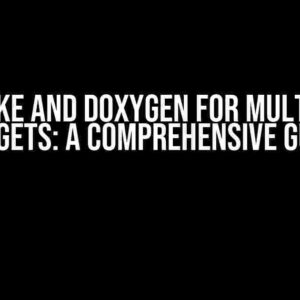If you’re working with C++20’s formatting library and trying to separate the interface and implementation of a `std::formatter` specialization, you might have stumbled upon a frustrating issue: constraints fail to work as expected. In this article, we’ll delve into the reasons behind this problem and provide clear instructions on how to overcome it.
- What is a `std::formatter` specialization?
- The Problem: separating the interface and implementation causes constraints to fail
- Why does separating the interface and implementation cause constraints to fail?
- Solution: using the `inline` keyword
- Best Practices for separating the interface and implementation of a `std::formatter` specialization
- Conclusion
What is a `std::formatter` specialization?
A `std::formatter` specialization is a way to customize the formatting behavior for a specific type. It allows you to define how your type should be formatted when used with the `std::format` function. A `std::formatter` specialization consists of two main components: the interface and the implementation.
The Interface: `std::formatter` concept
The interface is defined by the `std::formatter` concept, which specifies the required functions that a formatter must provide. These functions include `parse`, `format`, and `format_to`. The `parse` function is used to parse the format specification, while the `format` and `format_to` functions are responsible for formatting the value.
template <>
struct formatter<MyType> {
template <typename ParseContext>
constexpr auto parse(ParseContext &ctx) {
// parse the format specification
}
template <typename FormatContext>
auto format(const MyType &value, FormatContext &ctx) {
// format the value
}
template <typename OutputIt, typename FormatContext>
auto format_to(OutputIt &out, const MyType &value, FormatContext &ctx) {
// format the value to an output iterator
}
};
The Implementation: defining the formatting logic
The implementation is where you define the actual formatting logic for your type. This is where you write the code that takes the parsed format specification and the value to be formatted, and produces the final formatted string.
template <>
auto formatter<MyType>::format(const MyType &value, FormatContext &ctx) {
// get the format specification
auto spec = ctx.next();
// format the value based on the specification
if (spec.type == 'x') {
// format as hexadecimal
return format_to(ctx.out, value.get_hex());
} else if (spec.type == 'd') {
// format as decimal
return format_to(ctx.out, value.get_dec());
} else {
// handle other format specifications
}
}
The Problem: separating the interface and implementation causes constraints to fail
Now, let’s say you want to separate the interface and implementation of your `std::formatter` specialization into different files or translation units. This is a common practice to keep the interface separate from the implementation. However, when you do this, you might notice that the constraints on your `std::formatter` specialization start to fail.
// formatter_interface.h
template <>
struct formatter<MyType> {
template <typename ParseContext>
constexpr auto parse(ParseContext &ctx);
template <typename FormatContext>
auto format(const MyType &value, FormatContext &ctx);
template <typename OutputIt, typename FormatContext>
auto format_to(OutputIt &out, const MyType &value, FormatContext &ctx);
};
// formatter_implementation.cpp
template <>
auto formatter<MyType>::format(const MyType &value, FormatContext &ctx) {
// implementation of the format function
}
In this example, the interface is defined in `formatter_interface.h`, and the implementation is defined in `formatter_implementation.cpp`. However, when you try to use the `std::formatter` specialization with the `std::format` function, the constraints might fail, resulting in compilation errors.
Why does separating the interface and implementation cause constraints to fail?
The reason for this problem lies in the way template instantiations work in C++. When you separate the interface and implementation, the compiler sees two separate template definitions: one in the header file and one in the implementation file. This can lead to two different instantiations of the `std::formatter` specialization, which can cause the constraints to fail.
When the compiler sees the interface definition in the header file, it will instantiate the `std::formatter` specialization with the provided template parameters. However, when it sees the implementation definition in the implementation file, it will instantiate the specialization again with the same template parameters. This can result in two different instantiations of the same specialization, which can cause the constraints to fail.
Solution: using the `inline` keyword
To overcome this problem, you can use the `inline` keyword to specify that the implementation should be inlined into the header file. This tells the compiler to generate a single instantiation of the `std::formatter` specialization, rather than two separate ones.
// formatter_interface.h
template <>
struct formatter<MyType> {
template <typename ParseContext>
constexpr auto parse(ParseContext &ctx);
template <typename FormatContext>
auto format(const MyType &value, FormatContext &ctx);
template <typename OutputIt, typename FormatContext>
auto format_to(OutputIt &out, const MyType &value, FormatContext &ctx);
};
inline template <>
auto formatter<MyType>::format(const MyType &value, FormatContext &ctx) {
// implementation of the format function
}
By using the `inline` keyword, you ensure that the implementation is generated only once, in the header file, and is inlined into the interface definition. This allows the constraints to work correctly, and your `std::formatter` specialization should now work as expected.
Best Practices for separating the interface and implementation of a `std::formatter` specialization
To avoid constraints failures and ensure that your `std::formatter` specialization works correctly, follow these best practices:
- Keep the interface and implementation in the same header file, using the `inline` keyword to specify that the implementation should be inlined.
- Avoid separating the interface and implementation into different files or translation units.
- Use the `inline` keyword consistently throughout your code to ensure that the implementation is generated only once.
- Test your `std::formatter` specialization thoroughly to ensure that it works correctly with different format specifications and values.
By following these best practices, you can ensure that your `std::formatter` specialization works correctly and that the constraints are enforced as expected.
| Best Practice | Description |
|---|---|
| Keep interface and implementation in the same header file | Avoid separating the interface and implementation into different files or translation units. |
| Use the `inline` keyword consistently | Specify that the implementation should be inlined into the header file. |
| Test thoroughly | Test your `std::formatter` specialization with different format specifications and values. |
Conclusion
In this article, we’ve explored the reasons why separating the interface and implementation of a `std::formatter` specialization can cause constraints to fail. We’ve also provided clear instructions on how to overcome this problem by using the `inline` keyword and following best practices for separating the interface and implementation. By following these guidelines, you can ensure that your `std::formatter` specialization works correctly and that the constraints are enforced as expected.
If you have any questions or need further clarification on this topic, feel free to ask in the comments below. Happy coding!
- Why does separating the interface and implementation of a `std::formatter` specialization cause constraints to fail?
- What is a `std::formatter` specialization?
- The Interface: `std::formatter` concept
- The Implementation: defining the formatting logic
- The Problem: separating the interface and implementation causes constraints to fail
Share this:


